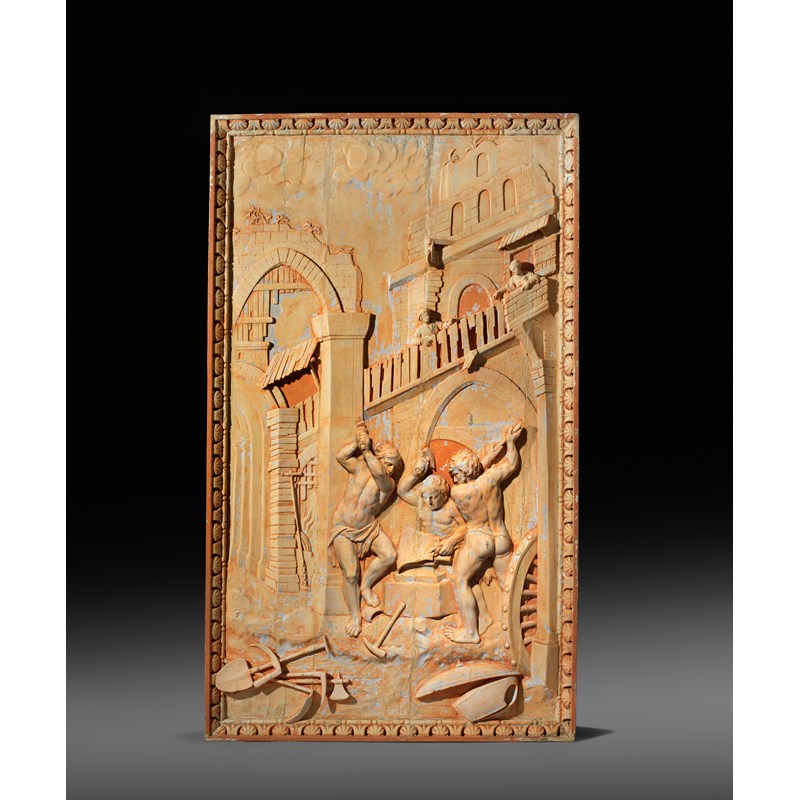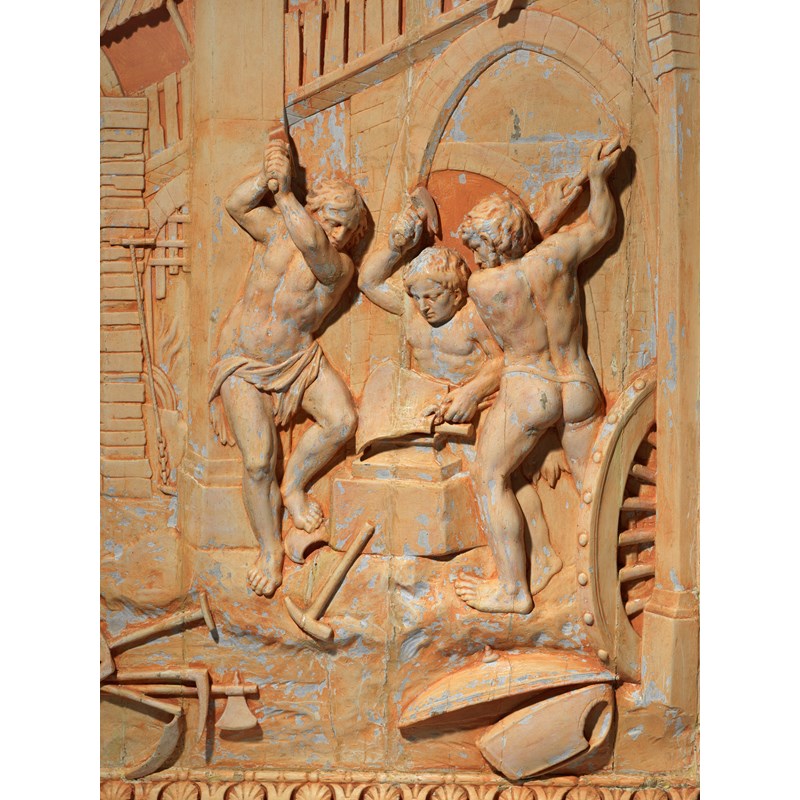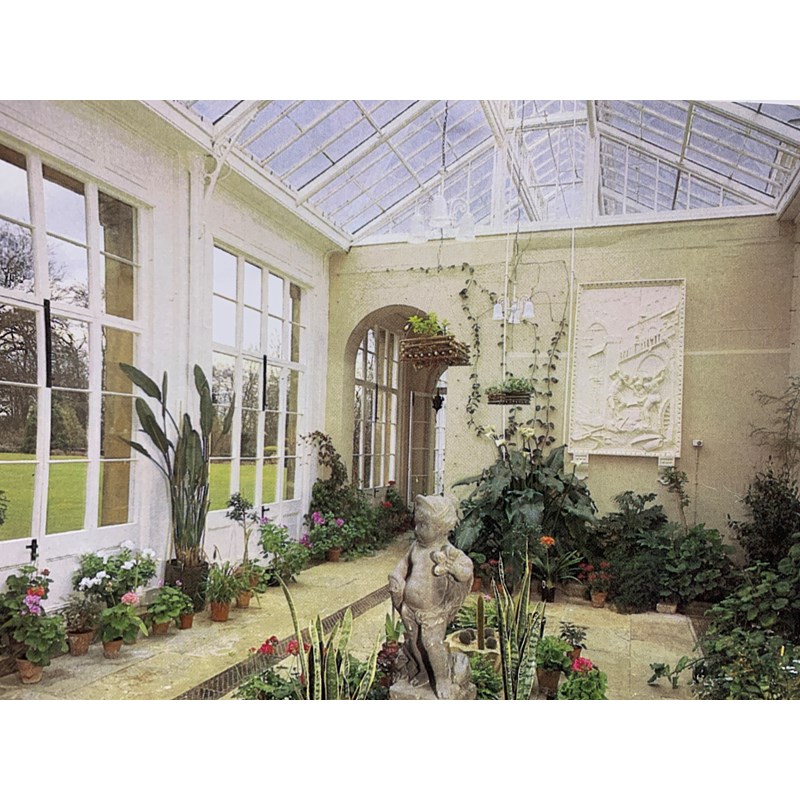Furniture, Works of Art and Clocks - 03 Jul 2019
A large limewood relief panel depicting the Forge of Vulcan
A large limewood relief panel depicting the Forge of Vulcan, carved with three central figures of Vulcan and his helpers, the Cyclopes, forging weapons and armour, directly copied from a painting by Theodoor Van Thulden (1606-1669), c.1649, with tools scattered on the floor, with a classical Renaissance style background of arches, the flaming fires of the forge visible and with a colonnade below a run of dilapidated palings and a pair of romantic figures, within a carved pine baton, shell and dart frame, later terracotta painted, possibly Dutch or German, late 17th / early 18th century, 210.7 x 123.5cm.
Provenance: The Conservatory of Buxted Park, Sussex.
The Subject Matter
Vulcan in Greek and Roman mythology is the god of fire and the blacksmith who forged the weapons of many gods and heroes. He is accompanied by his brawny assistants, the Cyclopes. The subject matter of Vulcan's forge was a very popular one during the 17th century with many famous paintings, including works by Velazquez, Teniers and Lucas Giordano. The magnificent Heaven room by Antonio Verrio at Burghley House, Stamford features a wonderful depiction of Vulcan and the Cyclopes and the fashion for classical subject matter of this type was very strong throughout the country houses of England and Europe.
The Sculptor
The central scene of the present lot is an almost direct copy of Theodoor van Thulden's (1606-1669) painting 'The Forge of Vulcan' painted in 1649 as part of a decorative scheme for the Paleis Huis ten Bosch in the Hague which is the residential Palace of the King and Queen of Holland. Van Thulden's painting can be found in the Oranjezaal (Orange Room) which was commissioned upon the death of Frederik Hendrik in 1647 and was built during the years 1648-1651 by Jacob van Campen. The painters chosen were considered the best in the Netherlands who painted in the style of Rubens and were mostly of Catholic origin. A total of thirty-one paintings decorate the room from floor to ceiling. Above one of the doors is a carved and painted wood relief panel by the famous Dutch sculptor Pieter Adriaensz. 't Hooft (1610-1650) and it is not inconceivable that the present panel was sculpted by a member of 't Hooft's workshop or circle. It is very skilfully carved with wonderful attention to the musculature of the central figures and with great depth and perspective, with the eye being led through the various arches and colonnades. Although depicting a very Italianate classical scene it does have a Northern European feel, the arches are slightly Gothic in their shape and the ragged palings on the balcony and the pent-roof of wooden planks are reminiscent of Dürer's engravings, thus pointing to either a Netherlandish or German origin.
The Provenance
Buxted Park was originally built in 1725 for Thomas Medley, in the early 19th century it passed by marriage to the Shuckburgh-Evelyn family and by the end of the 19th century Buxted again passed by marriage to the second viscount Portman who sold it in 1931 to the architect and art collector Basil Ionides and his wife Nellie, the daughter of the 1st Viscount Bearsted. With Nellie's fortune (as the Shell Oil heiress) and Basil's artistic eye they began restoring Buxted Park, utilising original 18th century architectural pieces from country houses around the country. A fireplace came from 19 Arlington Street, Robert Adam doors from nos. 23-25 Portland Place and an overmantel from Stowe, Buckinghamshire. Other items including the entrance doorway on the West side came from West Harling Hall, Norfolk, the seat of Richard Gipps Esq. The house was demolished in c.1932 and its contents were sold in two sales one in 1929 conducted by Puttick and Simpson and another in 1931. Intriguingly the shell and dart carved moulding on our Vulcan relief bears close resemblance to a George II carved pine fireplace originally from West Harling Hall which was sold by Christie's New York, Important American Furniture, 17th / 18th century January 2019, lot 1308.
One can speculate that the Vulcan relief was possibly part of an interior scheme at West Harling Hall, Norfolk, following the fashion for paintings of the Forge of Vulcan at English country houses, for example Luca Giordano's oil, c.1660, part of Sir Robert Walpole's Picture Gallery at the nearby Houghton Hall. The proximity to the Netherlands also adds an interesting link to a possible Dutch sculptor / place of manufacture.






 Live online bidding is available via our own
Live online bidding is available via our own